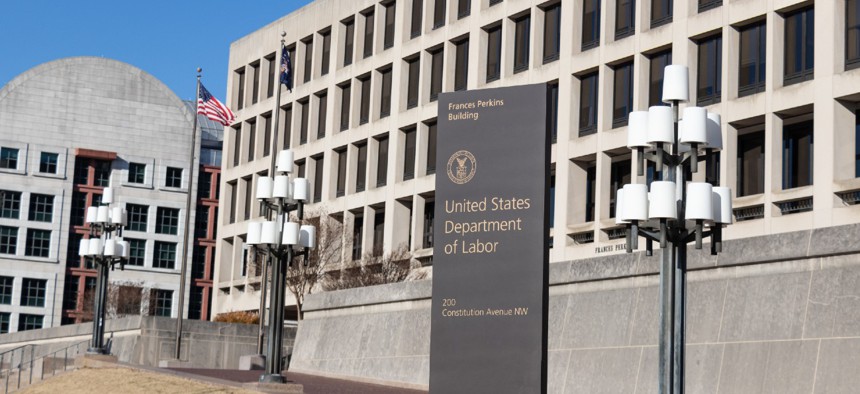Agency Hiring Initiatives and Other Takeaways From Biden's First Budget
Several agencies are looking to add thousands of new employees.
The Biden administration is planning to add 50,000 federal employees to agency rolls in fiscal 2022, targeting those surges at agencies that experienced the biggest losses under the Trump administration.
The hiring would reflect President Biden’s vision for partially reorienting the missions of many agencies and his overall push for a 16% increase in non-defense discretionary spending. While Government Executive previously covered some of the biggest winners in Biden’s budget based on the White House’s preliminary release of its discretionary spending plan, the more detailed blueprint released on Friday painted a clearer picture of how the administration would use its new resources and which offices would begin bringing on new staff.

Biden’s budget spelled out only a sliver of his policy priorities, with the document repeatedly pointing to his other proposed initiatives for details on his favored major agency reforms. Still, the blueprint set a wishlist for the White House as it begins negotiations with Congress in the appropriations process. Every major agency—with the exception of the Homeland Security and Commerce departments—would see a workforce boost, marking a significant departure from Trump’s proposals.

Here is a look at what the new hires would work on and other initiatives in Biden’s budget:
- Labor Department: At 14%, Labor would see the largest workforce growth of any Cabinet-level agency under Biden’s budget. Most of that increase would go toward enforcement within Labor’s workforce protection agencies, which would see their budgets grow by $7.5 billion. The Occupational Health and Safety Administration would see its inspector workforce double by the end of Biden’s first term. Labor noted it has lost 14% of its worker protection staff in recent years, limiting the department’s “ability to perform inspections and conduct investigations.” Significant hiring would also take place at Labor’s Office of Federal Contractor Compliance Programs.
- More Worker Protections: Coupled with the Labor hiring, the Biden administration is looking to boost compliance and enforcement with significant growth at the National Labor Relations Authority and Equal Employment Opportunity Commission. The three agencies together would seek to crack down on the misclassification of workers, the White House said. EEOC is aiming to boost its investigator workforce by more than 200 in fiscal years 2021 and 2022 to address its backlog, while NLRB would put most of its 15% hiring surge toward case handling.
- Interior Department: Interior would boost its rolls by 4,000 employees in fiscal 2022 under Biden’s blueprint, looking to offset a 7% workforce reduction under President Trump. The department is aiming to increase its number of employees by 11% since fiscal 2020. It is also reviewing the Trump administration’s decision to move the Bureau of Land Management’s headquarters from Washington, D.C., to Colorado, noting 80% of impacted staff declined to move. The department is evaluating the impact of the resulting lost experience and identifying its needs going forward. BLM would see an overall budget increase of 24%, while the Bureau of Indian Affairs would get a 29% boost. Biden would also give Interior $10 billion to establish the Civilian Climate Corps as part of a nearly 20% overall funding increase for the department.
- Treasury Department: Biden previously unveiled a plan to significantly boost hiring at the Internal Revenue Service to crack down on tax cheats, but the budget for the first time put forward specific targets. Treasury as a whole would see 6,000 new hires in fiscal 2022, with most of that going toward IRS enforcement. Biden requested $5.5 billion for those efforts. In addition to tax compliance, Biden said additional IRS funding would improve its IT systems, boost customer service and information reporting and support the new advance payments of the child tax credit.
- HUD: Much like IRS, the Housing and Urban Development Department—which saw a 20% staffing decline from 2012 to 2019—is looking to reverse longstanding cuts. HUD would receive $189 million to boost its rolls by 10% to address Biden’s housing priorities. Each office within HUD recently identified risks related to losses in institutional knowledge, the department said. In addition to redressing housing discrimination, Biden is looking to significantly boost funding for the Housing Choice Voucher Program.
- Green Fleet: As part of $36 billion in Biden’s budget for climate-related research and initiatives, the White House proposed $600 million to electrify the federal government’s vehicle fleet and buy related infrastructure. It also requested $2.4 billion over the next three years for the U.S. Postal Service to purchase electric vehicles. Unlike other recent presidents, Biden did not detail any proposal for larger USPS reform as part of his budget.
- Veterans Affairs: VA would see one of the smaller discretionary budget increases of any Cabinet-level agency, but its 10% boost would still allow the department to see its budget more than double over the last decade. It anticipates adding another 19,000 employees in fiscal 2022, most of which would go toward health care. VA said it expects to be busy next year due to a backlog of care deferred during the COVID-19 pandemic and as it boosts efforts on suicide prevention and substance use disorders.
- Hiring Reforms: The Biden administration is planning some new approaches to facilitate all of these hiring surges. As Government Executive previously reported, the administration plans to detail more specific changes to civil service rules and processes in the coming months when it releases its president’s management agenda. It previewed some of those reforms in the budget, such as what it is calling a new office to support “centralized governmentwide hiring actions that improve hiring outcomes for critical positions.” The Office of Personnel Management is also preparing "comprehensive guidance" on hiring flexibilities and best practices, the White House said, including new regulations to ease the rehiring of former federal workers.




